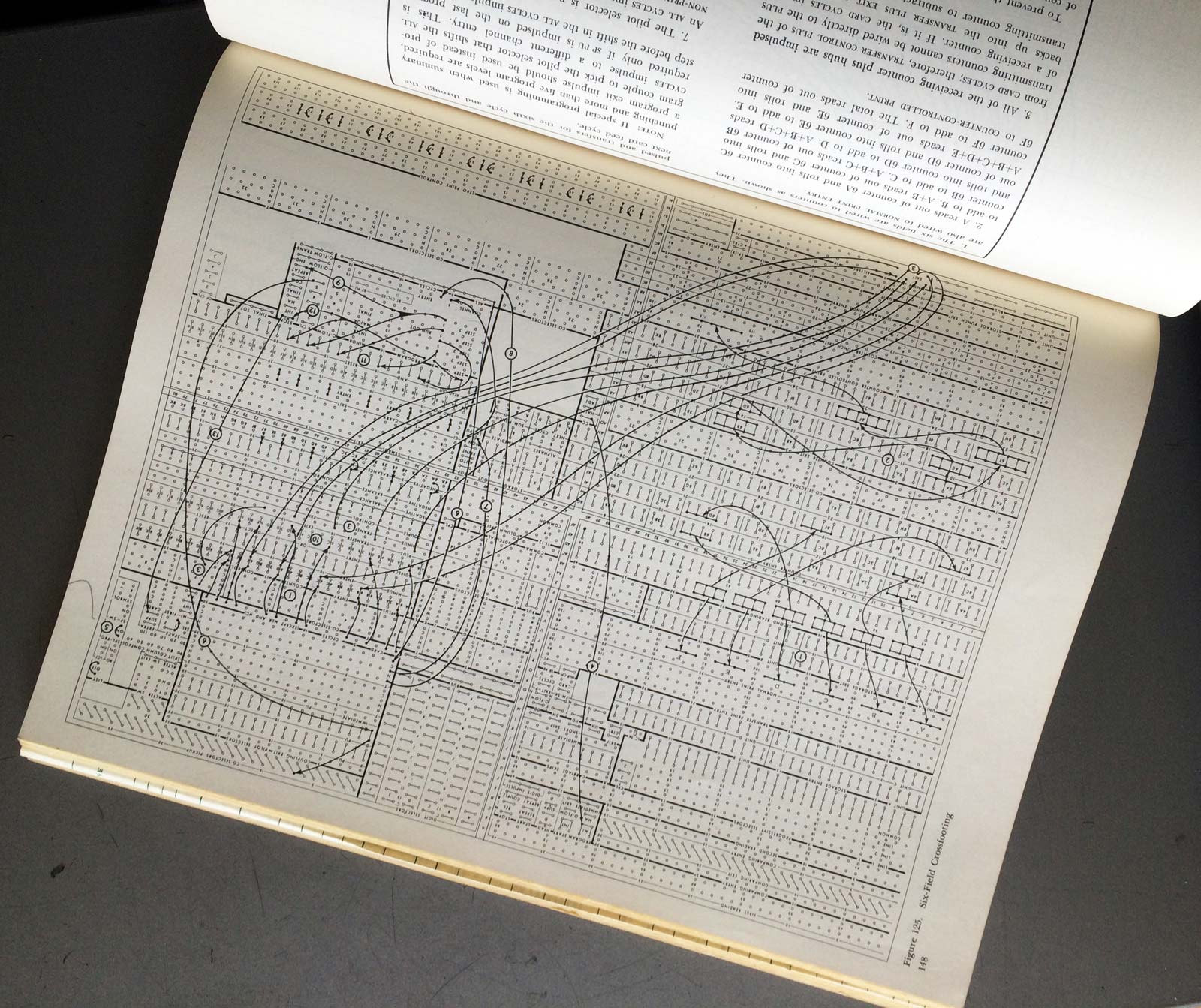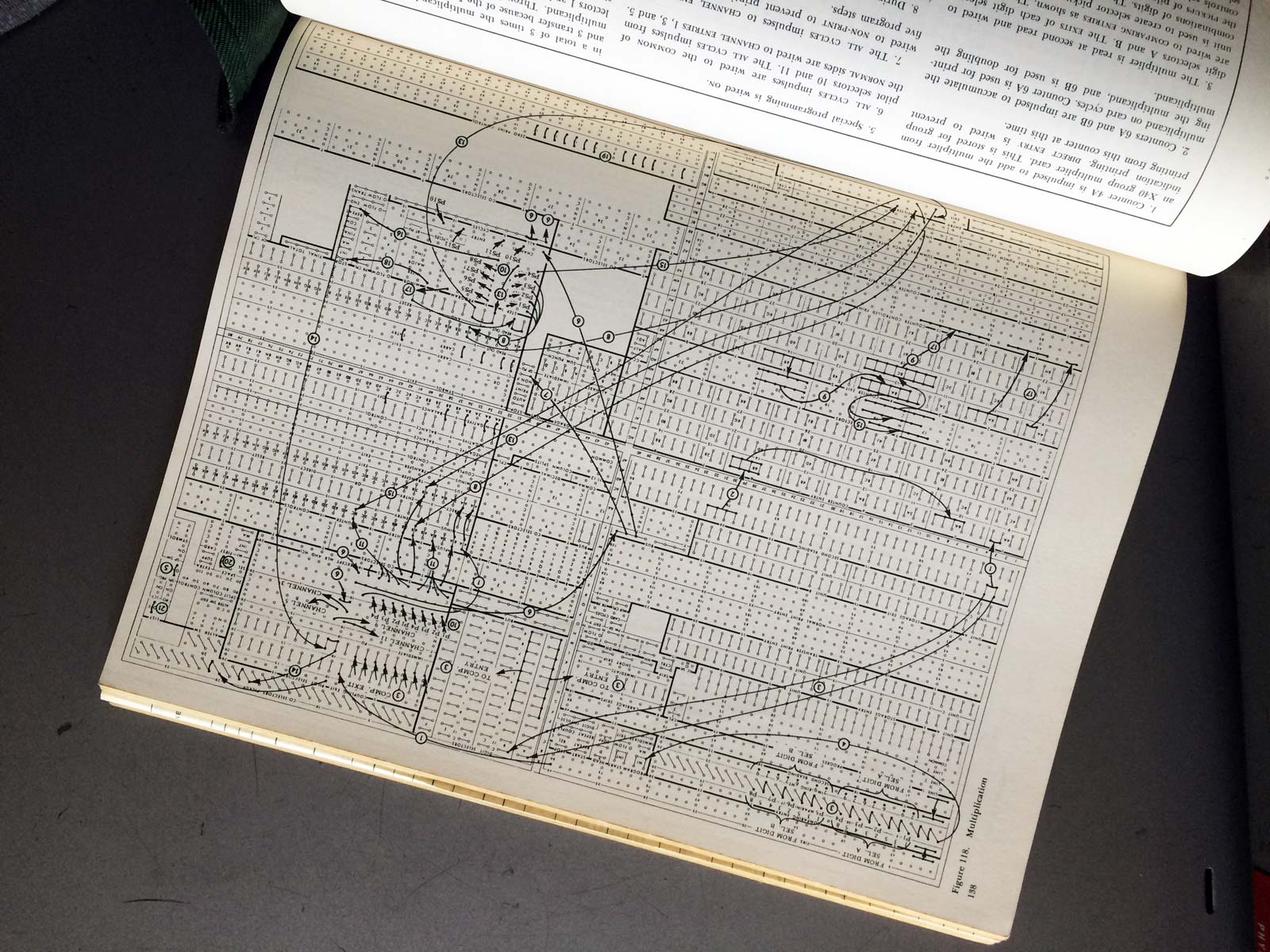The IBM 407 Accounting Machine
 The IBM 407 Accounting Machine (1949).
This was the last and best of the all-electromechanical IBM
accounting machines (previously known
as tabulators). The 407 reads a deck of
punched cards on its integrated card reader (left), accumulates totals,
subtotals, or other simple statistics in counters made of gears, and prints
the results on its integrated 120-column line printer (center). Speed: 100
to 150 cards per minute. The 407 replaced the earlier typebar printing
technology (used, e.g., in the 405
with a much faster print wheel mechanism.
The IBM 407 Accounting Machine (1949).
This was the last and best of the all-electromechanical IBM
accounting machines (previously known
as tabulators). The 407 reads a deck of
punched cards on its integrated card reader (left), accumulates totals,
subtotals, or other simple statistics in counters made of gears, and prints
the results on its integrated 120-column line printer (center). Speed: 100
to 150 cards per minute. The 407 replaced the earlier typebar printing
technology (used, e.g., in the 405
with a much faster print wheel mechanism.
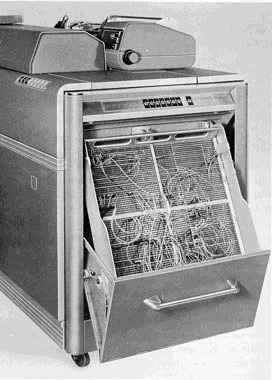 As with all IBM punch-card equipment except the key punch and sorter,
a control panel is wired to specify the details of operation:
what card columns to read and what to do with them, how to format the
report. Although the 407 is really just a big adding machine, creative use
could be made of the control program; for example, as described by Roger
L. Boyell in Programmed Multiplication on the IBM 407,
Journal of the ACM, Volume 4, Number 4, October, 1957, pp.442-449.
In 1955, the
407 was
adapted to act as an input/output device for
the IBM 650 computer, and would later perform similar
roles for other IBM calculators (such as the CPC-II)
and computers (7090); reportedly,
a 407 even served as the "system clock" for Columbia's
7094.
As with all IBM punch-card equipment except the key punch and sorter,
a control panel is wired to specify the details of operation:
what card columns to read and what to do with them, how to format the
report. Although the 407 is really just a big adding machine, creative use
could be made of the control program; for example, as described by Roger
L. Boyell in Programmed Multiplication on the IBM 407,
Journal of the ACM, Volume 4, Number 4, October, 1957, pp.442-449.
In 1955, the
407 was
adapted to act as an input/output device for
the IBM 650 computer, and would later perform similar
roles for other IBM calculators (such as the CPC-II)
and computers (7090); reportedly,
a 407 even served as the "system clock" for Columbia's
7094.
Fred Stone points out, "The speed
was a function of what you were doing. If you were just posting, reading a
card and printing, the maximum speed was a whopping 150 cards per minute.
There was a model E8, that was offered with the IBM 1620 to be used as an
offline printer. That was a stripped unit that would skip every third cycle
and was crippled to run at 100 cards per minute. With the purchase of 2
relays (if I remember corectly) and adding a jumper you could defeat the
crippling circuitry and get it back to 150 cpm."
Mike McCants, a 1620 programmer at Rice University in the 1960s, comments
(November 2002), "As one who helped perform such a modification in 1963, my
memory is a little different. There were already two extra relays in this
model E8. The purpose of the two extra relays was to count 1, count 2, and
then cause the machine to pause. Thus the 150 cards/minute printer was slowed
to 100 cards/minute. My memory is that it took us only an hour or so to read
the documentation in the back of the cabinet and figure out how to bypass the
two relays and restore the 407 to its rated speed of 150 cards/minute. This
happened about one hour after the SE finished installing the
machine
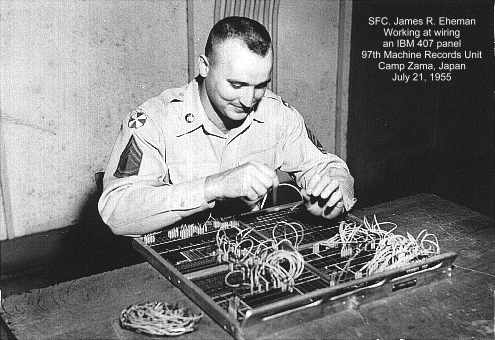 The control panel was about 16 inches square with metal rim and grasping
handle, containing a matrix of holes sectioned off into functional areas with
small labels printed in white. To program the machine to do a particular task
(such as read a deck of cards, print each card in a certain format, add up the
numbers in columns 40-48, and print the total), jumper wires of various
lengths and colors were inserted to connect pairs of holes, such as card
columns to printer columns, card columns to accumulators, and (always) "CI to
C". When your program is complete, you open the door on the right, put in the
control panel, then close the door; thus different programs could be easily
swapped in and out. Various other IBM EAM and unit record equipment were
programmed the same way. Probably the most common (and certainly most
mundane) use of the 407 in later years was offline listing of card decks onto
paper.
The control panel was about 16 inches square with metal rim and grasping
handle, containing a matrix of holes sectioned off into functional areas with
small labels printed in white. To program the machine to do a particular task
(such as read a deck of cards, print each card in a certain format, add up the
numbers in columns 40-48, and print the total), jumper wires of various
lengths and colors were inserted to connect pairs of holes, such as card
columns to printer columns, card columns to accumulators, and (always) "CI to
C". When your program is complete, you open the door on the right, put in the
control panel, then close the door; thus different programs could be easily
swapped in and out. Various other IBM EAM and unit record equipment were
programmed the same way. Probably the most common (and certainly most
mundane) use of the 407 in later years was offline listing of card decks onto
paper.
Photo: From the website of Gary Eheman at IBM, used by permission. The control panel programmer is his dad. (I was doing the same thing in the Army 10 years later, but with considerably fewer stripes.) The 407 photo on top is from the IBM archive and the programming photo was an Army recruiting shot. And here are shots of my old manual:
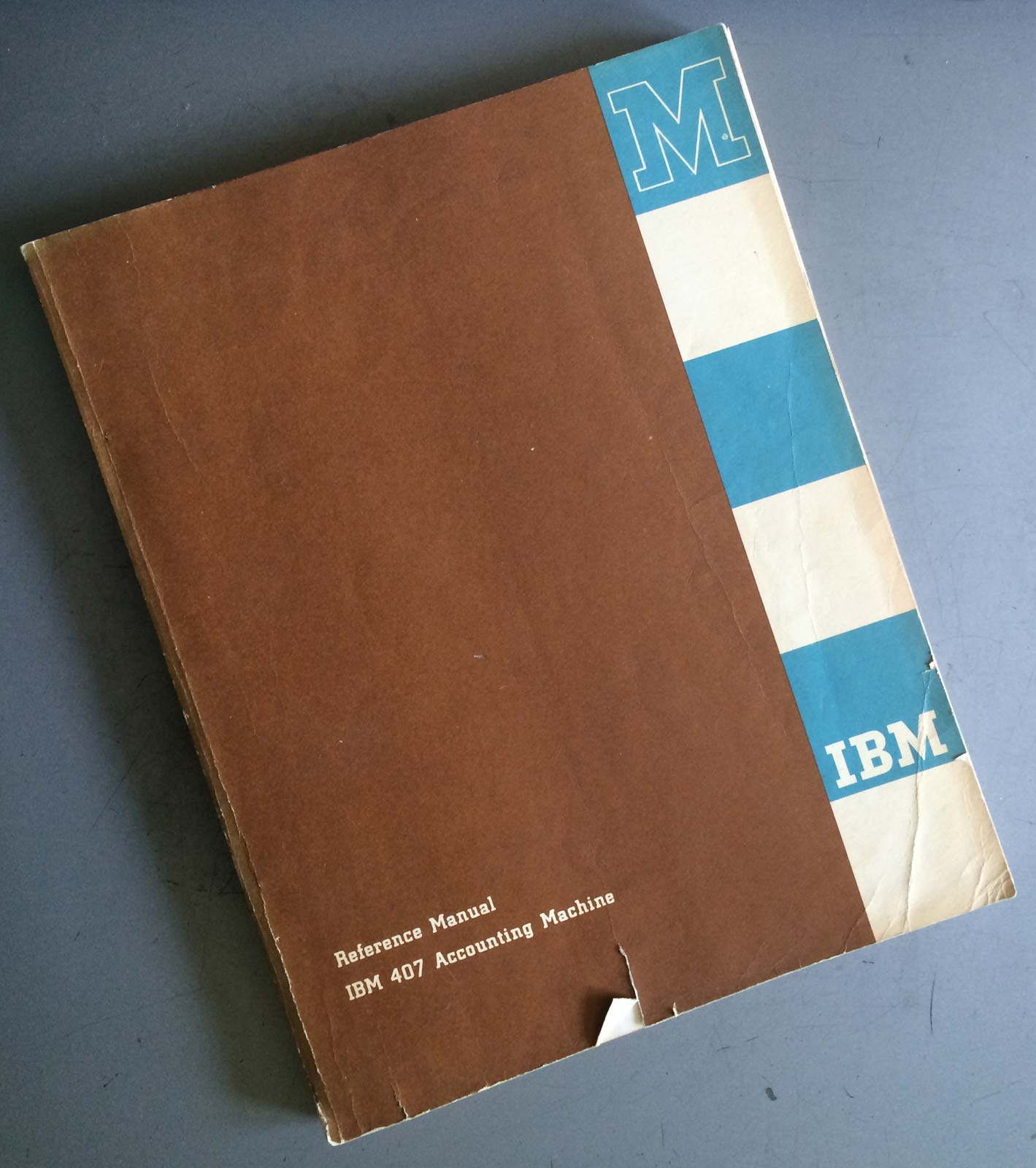
|
| IBM 407 Reference Manual 1950 |
|
- Reference Manual, IBM 407 Accounting Machine, International Business Machines Corporation, Data Processing Division, 112 East Post Road, White Plains, New York: A24-1011-0 (1950).
- Bashe, Charles J.; Lyle R. Johnson; John H. Palmer; Emerson W. Pugh, IBM's Early Computers, MIT Press (1985).
- IBM 407 accounting machine (IBM history archive)
- Columbia University Machine Room Gallery 1965.
- Overview of IBM Tabulators and Accounting Machines.
- IBM Control Panels (plugboards).
- Herman Hollerith and his 1890 Census Tabulator.
- IBM 285. IBM 402. IBM 405
Translations of this page courtesy of...
| Language | Link | Date | Translator | Organization |
|---|---|---|---|---|
| Belarusian | Беларуская | 2023/08/22 | Vladyslav Byshuk | Владислав Бишук | studycrumb.com |
| Finnish | Suomi | 2023/08/31 | Kerstin Schmidt | writemyessay4me.org |
| French | Français | 2023/08/25 | Kerstin Schmidt | prothesiswriter.com |
| German | Deutsch | 2023/08/25 | Kerstin Schmidt | writemypaper4me.org |
| Italian | Italiano | 2023/08/31 | Kerstin Schmidt | admission-writer.com |
| Norwegian | Norsk (bokmål) | 2022/08/10 | Rune | Bildeler på nett |
| Polish | Polski | 2023/08/25 | Kerstin Schmidt | justdomyhomework.com |
| Russian | Русский | 2023/08/22 | Vladyslav Byshuk | Владислав Бишук | skyclinic.ua |
| Spanish | Español | 2023/08/31 | Kerstin Schmidt | pro-academic-writers.com |
| Ukrainian | Українська | 2023/08/22 | Vladyslav Byshuk | Владислав Бишук | studybounty.com |
